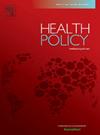Common institutional ownership and the erosion of competition in the American health insurance market: A quantitative analysis
IF 3.4
3区 医学
Q1 HEALTH CARE SCIENCES & SERVICES
引用次数: 0
Abstract
Background
Empirical studies have shown that when large institutional investors and private equity funds own a significant stake in multiple publicly traded firms within an industry, this common ownership may lead to anti-competitive behavior. In 2010, the Affordable Care Act (ACA) was passed. This law created health insurance exchanges that allowed for Americans to purchase health insurance plans directly on a marketplace. The insurers on this marketplace have common institutional owners, that could influence the level of competition in these markets.
Objective
To assess the causal effects of common ownership on competition in the US health insurance market.
Methods
To identify the causal impact of common ownership, I use two empirical strategies: the Arellano-Bond Dynamic Panel Model and Bartik-style Instruments. Data on firm ownership came the paper, “Common Ownership Data: Scraped SEC form 13F filings for 1999-2017” by Matthew Backus, Christopher Conlon, and Michael Sinkinson.
Results
The results show that a one standard deviation increase in common ownership leads to a 7.7 % increase in monthly premiums charged for certain health insurance plans. This finding is robust to different model specifications and suggests that common ownership reduces competition in the health insurance exchanges.
Conclusions
The results from this paper indicate that policymakers and regulators need to formulate policies that limit the amount that institutional investors and private equity funds can own of companies in the health insurance industry in the US. Additionally, policymakers need to make more data on firm ownership available, as the data that is available has quality issues.
共同机构所有权与美国健康保险市场竞争的侵蚀:一个定量分析
实证研究表明,当大型机构投资者和私募股权基金在一个行业内的多家上市公司中拥有大量股份时,这种共同所有权可能会导致反竞争行为。2010年,平价医疗法案(ACA)获得通过。这项法律建立了健康保险交易所,允许美国人直接在市场上购买健康保险计划。这个市场上的保险公司有共同的机构所有者,这可能会影响这些市场的竞争水平。目的评价共同所有制对美国医疗保险市场竞争的因果效应。为了确定共同所有权的因果影响,我使用了两种实证策略:Arellano-Bond动态面板模型和bartik风格工具。关于公司所有权的数据来自马修·巴克斯、克里斯托弗·康伦和迈克尔·辛金森的论文《共同所有权数据:1999-2017年美国证券交易委员会表格13F文件》。结果结果表明,共同所有权每增加一个标准差,就会导致某些健康保险计划的月保费增加7.7%。这一发现对不同的模型规格是稳健的,并表明共同所有权减少了健康保险交易所的竞争。结论本文的研究结果表明,政策制定者和监管机构需要制定政策,限制机构投资者和私募股权基金在美国医疗保险行业的持股数量。此外,决策者需要提供更多关于企业所有权的数据,因为现有数据存在质量问题。
本文章由计算机程序翻译,如有差异,请以英文原文为准。
求助全文
约1分钟内获得全文
求助全文
来源期刊

Health Policy
医学-卫生保健
CiteScore
6.40
自引率
6.10%
发文量
157
审稿时长
3-8 weeks
期刊介绍:
Health Policy is intended to be a vehicle for the exploration and discussion of health policy and health system issues and is aimed in particular at enhancing communication between health policy and system researchers, legislators, decision-makers and professionals concerned with developing, implementing, and analysing health policy, health systems and health care reforms, primarily in high-income countries outside the U.S.A.
 求助内容:
求助内容: 应助结果提醒方式:
应助结果提醒方式:


